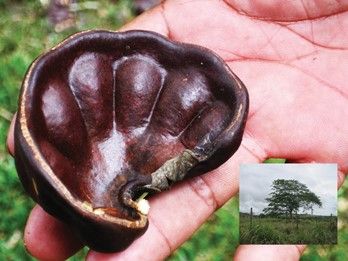Family
Fabaceae, pea family
Genus
Enterolobium comes from two Greek words: entero, which means “intestines,” and lobium, which means “lobe,” together referring to the resemblance of seedpods common amongst species of this genus to curled intestines.
Species
The species name cyclocarpum is a combination of the Greek words cyclo, meaning “circle,” and carpus, which means “fruit.” The name is also in reference to the curled seedpods produced by this species.
Common Name
Ear tree, Guanacaste
The name “ear tree” is in reference to the resemblance between its semicircular seedpod and a human or monkey ear.
Description
This deciduous tree is native to Mexico, Central America, and northern South America, but has also been introduced in Florida, the Caribbean Islands, Cuba, Puerto Rico, and Hawaii. It can grow in a wide range of soil types, including clayey, sandy, and alkaline soils. Though ear tree grows best in regions with a dry season, it prefers warm and moist climates.

Credit: Richard McNeill 2012 / CC BY-NC 2.0
When grown in direct sunlight, ear tree can reach heights of up to 75 feet. Its leaves are light green, oblong in shape, and have an alternate arrangement that is bipinnately compound. Each leaflet is ½ inch long, and multiple leaflets make up 6- to 16-inch-long leaves. The bark is light gray with reddish-brown lenticels or striations that occur vertically along the trunk and branches, while spurs may be present at the base of the tree. Small greenish-white flowers appear in globular clusters in the spring, and fruits are 3- to 4½-inch-long, dark brown, curled pods that are depressed flat enough to reveal the location of seeds within them. Each pod contains 8–16 oval-shaped seeds that loosen themselves from the walls of the fully ripened pod approximately one year later.
Allergen
Inhalation of sawdust from this tree can be irritating to the upper respiratory system.
Storm Tolerance
Ear tree is not able to withstand strong winds, and its limbs are easily broken during storms.
Applications
Commercial/Practical
In Central America, some people extract the seeds from pods and grind them into flour. Additionally, seeds can be roasted and eaten whole. The ear tree is commonly used as a shade tree on coffee plantations and on cattle ranches where it serves as a source of nourishment for cattle. The heartwood is malleable and highly resistant to fungus and dry-wood termites, and it is utilized in furniture components for paneling and as a veneer.
Horticultural
Mature trees have a wide, spreading crown that makes for a useful shade tree in parks or at schools. However, the crown may be too large for planting in residential areas, and given ear tree’s susceptibility to limb breakage during high wind events, it may also be a risky choice near homes or buildings in Florida. This tree is not tolerant of salty conditions and is, therefore, best planted inland.
Additional References
Gargiullo, M., & Magnuson, B. (2008). A field guide to plants of Costa Rica. Oxford University Press.
Hughes, C. E., & Stewart, J. L. (1990). Enterolobium cyclocarpum: The Ear Pod Tree for Pasture, Fodder, and Wood. https://winrock.org/?s=Enterolobium+cyclocarpum%3A+The+Ear+Pod+Tree+for+Pasture%2C+Fodder%2C+and+Wood
Watkins, J. V., Sheehan, T. J., & Black, R. J. (2005). Florida Landscape Plants: Native and Exotic. (2nd ed). Gainesville, FL: University Press of Florida.